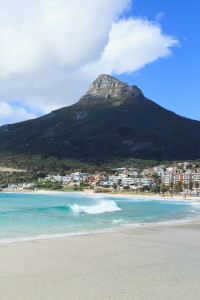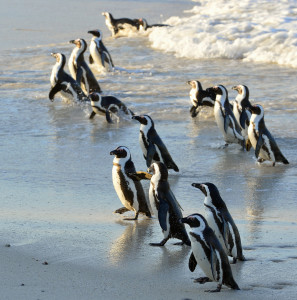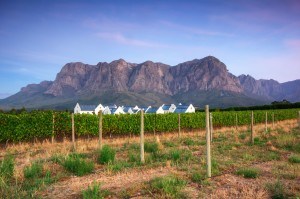Today we have a Conference Preview from Jim Clarke about the cool-climate wines of South Africa. Yes, you read that correctly – the Cape, in spots, is Cool! Read on for information on the cool-climate wines of South Africa, and Jim’s upcoming conference session!
When I was studying to become a sommelier, I was often asked the question, “Do you go there to surf or to ski”? It was intended as a quick way to remind oneself if a winegrowing area was a warm region or a cool one. It’s a handy mnemonic – albeit one that unfortunately underlines American’s poor sense of geography -maybe they can’t find Austria on a map, but they’ve seen Austrian skiers in the Olympics on TV, so: cool climate!
For the climate of South Africa, we think of surfers – possibly being attacked by those crazy great whites that leap right out of the water – so: warm climate. (For a less morbid surfing encounter, check out Bernard Le Roux, winemaker at Zorgvliet, being knocked off his board by some dolphins at last year’s Vintner’s Surf Classic.)
If you look closer, however, you’ll notice something else about those South African surfers: the wetsuits. There’s nothing warm about the water off the coast of South Africa – after all, the next stop on your way south would be Antarctica! The ocean currents that cool the vineyards of South Africa come up from Antarctica. There are penguins happily inhabiting the Cape Peninsula to prove it!
Sommeliers often sum up the Cape’s climate as “Mediterranean,” but there’s a lot more to it than that. While I suspect South Africa’s Olympic ski team sounds as likely a competitor as Jamaica’s bobsledders, in the right spots vines find it plenty cool enough. Some parts of South Africa are specifically cool enough for reds like Pinot Noir; or lighter, peppery styles of Syrah (many, nonetheless, inexplicably labeled “Shiraz”) and for whites such as Sauvignon Blanc, Gewurztraminer, or even Riesling.
Even warm areas such as an arid, mountainous landscape, once may encounter a change of conditions if one moves just a few meters in the right direction. For example, the Jordan Winery lies atop a dome-shaped hill in Stellenbosch. On north-facing slopes (away from the cold winds, and toward the sun) they grow Cabernet Sauvignon alongside Syrah and Chardonnay; but one south-facing slope right in the middle of the Chardonnay vineyard is cool enough to produce and elegant and balanced Riesling.
More importantly, however, especially in a time where the market is trending toward more acid-driven, lower-alcohol wines, are the regions where cool spots are not the exceptions but the rule. Constantia – South Africa’s most famous historic wine region – is one example. Located just a few miles from Cape Town, this region produced sweet wines in the 18th and 19th centuries that were the envy of Europe, lauded by the likes of Baudelaire and Napoleon. Today this small region of a dozen or so producers is focused on Sauvignon Blanc, though some make elegant Chardonnays, and some reds in the southern (but more north-facing) part of the district. All the Constantia vineyards are just a few miles from the penguins and sharks (and more relevantly, the winds) of False Bay.
Most of South Africa’s other cool climate areas don’t have the history and pedigree of Constantia, largely because of regulations and a quota system during much of the 20th century that discouraged plantings there (cool climates can be more challenging to work in, so why not simply plant in warmer, higher-yielding spots?). That changed in 1992, just as apartheid was crumbling, and many would-be winegrowers started exploring.
The Cape South Coast region was largely developed at this time, and is now a source of some of the country’s most esteemed wines. Districts within the region each have their own character. In Elgin, apple orchards were replaced with grapes, and the bowl-shaped basin proved effective at capturing cool air from the ocean just a few miles to the south. Near Hermanus, where whales come so close to shore they can be easily viewed while standing on the shore, the narrow Hemel-en-Aarde Valley draws in the cool air, and the vineyards there produce South Africa’s most consistently lauded Pinot Noirs and Chardonnays.
The west coast, north of Cape Town, also has its own wind-battered vineyards, notably the two “D’s” Durbanville and Darling, both devoted largely to Sauvignon Blanc, both not far from the beach. Which – surfing mnemonics aside – makes sense.
We humans go to the beach to cool off, right? Well, so do South Africa’s grapes.
Jim Clarke is the U.S. Marketing Manager for Wines of South Africa (WOSA), a levy-supported organization devoted to promoting South African wine exports. Previous to joining WOSA Jim was a sommelier in New York City, running the wine programs at Megu New York for five years and then the Armani Ristorante for two. In addition, he writes about wine, beer, and spirits for a number of publications both trade and consumer; his pieces have appeared in the World of Fine Wine, Details, the San Francisco Chronicle, and elsewhere. Jim has spoken or lectured at a number of events including TexSom and the American Wine Society Conference.
Jim’s session on the cool-climate wines of South Africa, entitled “How Cool is the Cape” will be held on Thursday, August 13th at 8:45 am as part of the 39th Annual Conference of the Society of Wine Educators.


